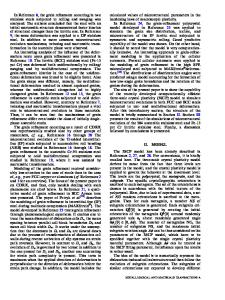Revealing the small post-necking elongation in twinning-induced plasticity steels
- PDF / 4,867,019 Bytes
- 18 Pages / 595.276 x 790.866 pts Page_size
- 57 Downloads / 384 Views
Revealing the small post-necking elongation in twinning-induced plasticity steels Joong-Ki Hwang1,* 1
School of Mechanical Engineering, Tongmyong University, Busan 48520, Republic of Korea
Received: 7 October 2019
ABSTRACT
Accepted: 13 February 2020
The mechanism of small post-necking elongation (PE) in twinning-induced plasticity (TWIP) steels has been investigated from a metallurgical and mechanical engineering perspective to understand and increase the PE. To achieve the above aims, seven TWIP steels with systematic variations in chemical composition, grain size, and pre-strain were prepared. The steels were then analyzed using tensile curves, electron backscatter diffraction techniques, numerical simulation, and a comparison study with other metals. The region of diffuse necking was not observed in C-added TWIP steels due to the negative strain rate sensitivity (m). The negative m value led to strain concentration at the narrow necking region, leading to localized necking and then shear cracks, resulting in the small PE. The dynamic strain aging (DSA) effect was closely related to the negative m value in TWIP steels. Therefore, the PE had a strong linear relationship with the onset strain of serration in the tensile curve. The texture development with an increased dislocation density by pre-strain can suppress the localized necking in TWIP steels, leading to an improvement in the PE. TWIP steel with a larger grain size had higher PE because the DSA was suppressed with increasing grain size.
Published online: 1 April 2020
Ó
Springer Science+Business
Media, LLC, part of Springer Nature 2020
Introduction Ductility means the ability of a material to undergo plastic deformation without fracture, and it is limited to a certain degree since the strain hardening rate of a material decreases with strain. Ductility is generally evaluated by measuring the total elongation (TE) and reduction of area (RA) of a specimen during a tensile test [1], and these values are of foremost importance in the fields of materials and mechanical engineering. Plastic deformation will cease when the material
Address correspondence to E-mail: [email protected]
https://doi.org/10.1007/s10853-020-04477-x
exhausts its ability to redistribute strain, which is called fracture, failure, and rapture. That is, ductility is closely related to the redistribution of strain or resistance to the onset of localized necking during plastic deformation. Once the strain hardening of material is unable to keep up with geometric softening during the tensile test, strain redistribution is stopped, and a necking is generated. The stress at the necking region is much higher than the stress in the non-necking regions due to the stress concentration and the stress along the radial direction of the
8286
J Mater Sci (2020) 55:8285–8302
specimen, which means that necking introduces a complex triaxial stress state in a specimen during a tensile test. Accordingly, we can divide the tensile behavior into two parts, before necking and after necking, as follows
Data Loading...











